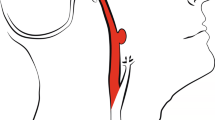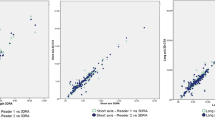Abstract
Purpose
Delayed cerebral ischemia represents a significant cause of poor functional outcome for patients with vasospasm after subarachnoid hemorrhage. We investigated whether delayed cerebral ischemia could be detected by the arterial opacification of internal carotid artery at the level of the skull base.
Methods
In this exploratory, nested retrospective cohort diagnostic accuracy study, patients with clinical and/or transcranial Doppler suspicion of vasospasm who underwent four-dimensional computed tomography angiography were included. They were split into two groups for the main endpoint analysis, according to the actually adopted morphological (cerebral infarction) and clinical criteria (neurologic deterioration) of delayed cerebral ischemia. Opacification with a temporal resolution of 0.15 s of both internal carotid arteries at the skull base level was obtained through a semi-automated segmentation method based on skeletonization, and analyzed by a wavelet transform (rbio2.2, level 1). The results obtained by k-means clustering were analyzed with regard to the state of delayed cerebral infarction.
Results
Over ten patients included and analyzed, five patients presented a delayed cerebral ischemia, two of them in both side. The semi-automated processing and analysis clustered two different types of opacification curves. The obtaining of a nonlinear opacification pattern was associated (p < 0.001) with delayed cerebral ischemia.
Conclusions
The analysis of arterial opacification of internal carotid arteries at skull base by the proposed processing is feasible and leads to cluster two types of opacification that may help to early detect and prevent delayed cerebral ischemia, in particularly when examinations are artifacted by aneurysm treatment materials.




Similar content being viewed by others
References
Kassell NF, Sasaki T, Colohan AR, Nazar G (1985) Cerebral vasospasm following aneurysmal subarachnoid hemorrhage. Stroke 16:562–572
Pluta RM, Hansen-Schwartz J, Dreier J, Vajkoczy P, Macdonald RL, Nishizawa S, Kasuya H, Wellman G, Keller E, Zauner A, Dorsch N, Clark J, Ono S, Kiris T, Leroux P, Zhang JH (2009) Cerebral vasospasm following subarachnoid hemorrhage: time for a new world of thought. Neurol Res 31:151–158
Galeffi F, Degan S, Britz G, Turner DA (2016) Dysregulation of oxygen hemodynamic responses to synaptic train stimulation in a rat hippocampal model of subarachnoid hemorrhage. J Cereb Blood Flow Metab 36:696–701
Brami J, Chousterman B, Boulouis G, Le Dorze M, Majlath M, Saint-Maurice JP, Civelli V, Froelich S, Houdart E, Labeyrie MA (2020) Delayed cerebral infarction is systematically associated with a cerebral vasospasm of large intracranial arteries. Neurosurgery 86:E175–E183
Rowland MJ, Hadjipavlou G, Kelly M, Westbrook J, Pattinson KT (2012) Delayed cerebral ischaemia after subarachnoid haemorrhage: looking beyond vasospasm. Br J Anaesth 109:315–329
Francoeur CL, Mayer SA (2016) Management of delayed cerebral ischemia after subarachnoid hemorrhage. Crit Care 20:277
Djelilovic-Vranic J, Basic-Kes V, Tiric-Campara M, Djozic E, Kulenovic J (2017) Follow-up of vasospasm by transcranial doppler sonography (TCD) in subarachnoid hemorrhage (SAH). Acta Inform Med 25:14–18
Anderson GB, Ashforth R, Steinke DE, Findlay JM (2000) CT Angiography for the detection of cerebral vasospasm in patients with acute subarachnoid hemorrhage. AJNR Am J Neuroradiol 21:1101–1015
Greenberg ED, Gobin YP, Riina H, Johnson CE, Tsiouris AJ, Comunale J, Sanelli PC (2011) Role of CT perfusion imaging in the diagnosis and treatment of vasospasm. Imaging Med 3:287–297
Kortman HG, Smit EJ, Oei MT, Manniesing R, Prokop M, Meijer FJ (2015) 4D-CTA in neurovascular disease: a review. Am J Neuroradiol 36:1026–1033
Barfett JJ, Velauthapillai N, Fierstra J, Crawley A, Coolens C, Crean A, Jaskolka J, Dufort P, Krings T, Mikulis D (2014) Intra-vascular blood velocity and volumetric flow rate calculated from dynamic 4D CT angiography using a time of flight technique. Int J Cardiovasc Imaging 30:1383–1392
Dissaux B, Ognard J, Cheddad El Aouni M, Nonent M, Haioun K, Magro E, Gentric JC (2020) Volume variation may be a relevant metric in the study of aneurysm pulsatility: a study using ECG-gated 4D-CTA (PULSAN). J Neurointerv Surg 12:632–636
Sano H, Satoh A, Murayama Y, Kato Y, Origasa H, Inamasu J, Nouri M, Cherian I, Saito N, Members of the 38 Registered Institutions, and WFNS Cerebrovascular Disease & Treatment Committee (2015) Modified World Federation of Neurosurgical Societies subarachnoid hemorrhage grading system. World Neurosurg 83:801–807
Frontera JA, Claassen J, Schmidt JM, Wartenberg KE, Temes R, Connolly ES Jr, MacDonald RL, Mayer SA (2006) Prediction of symptomatic vasospasm after subarachnoid hemorrhage: the modified fisher scale. Neurosurgery 59:21–27
Binaghi S, Colleoni ML, Maeder P, Uské A, Regli L, Dehdashti AR, Schnyder P, Meuli R (2007) CT angiography and perfusion CT in cerebral vasospasm after subarachnoid hemorrhage. AJNR Am J Neuroradiol 28:750–758
Letourneau-Guillon L, Farzin B, Darsaut TE, Kotowski M, Guilbert F, Chagnon M, Diouf A, Roy D, Weill A, Lemus M, Bard C, Belair M, Landry D, Nico L, Tellier A, Jabre R, Kauffmann C, Raymond J (2020) Reliability of CT angiography in cerebral vasospasm: a systematic review of the literature and an inter- and intraobserver study. Am J Neuroradiol 41:612–618
Ognard J, Dissaux B, Haioun K, Gentric JC, Ben Salem D (2019) A “one-stop-shop” 4D CTA protocol using 320-row CT for advanced imaging in acute ischemic stroke: a technical note. Eur Radiol 29:4390–4936
Dissaux B, Gentric J-C (2020) Toward a dynamic and quantifiable study of vascular cerebral pathologies. J Neuroradiol. 22:S0150-9861
Sanelli PC, Anumula N, Johnson CE, Comunale JP, Tsiouris AJ, Riina H, Segal AZ, Stieg PE, Zimmerman RD, Mushlin AI (2013) Evaluating CT perfusion using outcome measures of delayed cerebral ischemia in aneurysmal subarachnoid hemorrhage. Am J Neuroradiol 34:292–298
Vergouwen MD, Vermeulen M, van Gijn J, Rinkel GJ, Wijdicks EF, Muizelaar JP, Mendelow AD, Juvela S, Yonas H, Terbrugge KG, Macdonald RL, Diringer MN, Broderick JP, Dreier JP, Roos YB (2010) Definition of delayed cerebral ischemia after aneurysmal subarachnoid hemorrhage as an outcome event in clinical trials and observational studies. Stroke 41:2391–2395
Kerschnitzki M, Kollmannsberger P, Burghammer M, Duda GN, Weinkamer R, Wagermaier W, Fratzl P (2013) Architecture of the osteocyte network correlates with bone material quality. J Bone Miner Res 28:1837–1845
Jin X, Kim J (2017) A 3D skeletonization algorithm for 3D mesh models using a partial parallel 3D thinning algorithm and 3D skeleton correcting algorithm. Appl Sci 7:139
Zhu ZK, Yan R, Luo L, Feng ZH, Kong FR (2009) Detection of signal transients based on wavelet and statistics for machine fault diagnosis. Mech Syst Signal Process 23:1076–1097
Addison PS (2005) Wavelet transforms and the ECG: a review. Physiol Meas 26:R155–R199
Faust O, Acharya UR, Adeli H, Adeli A (2015) Wavelet-based EEG processing for computer-aided seizure detection and epilepsy diagnosis. Seizure 26:56–64
Indrusiak MLS, Kozakevicius AJ, Möller SV (2016) Wavelet analysis considerations for experimental nonstationary flow phenomena. Therm Eng 15:10
Bedekar D, Nair A, Vince DG (2005) Choosing the optimal mother wavelet for decomposition of radio-frequency intravascular ultrasound data for characterization of atherosclerotic plaque lesions. In: Walker WF, Emelianov SY (eds) Proceeding on SPIE 5750, medical imaging 2005: ultrasonic imaging and signal processing, p 490
Salwani MD, Jasmy Y (2005) Relative wavelet energy as a tool to select suitable wavelet for artifact removal in EEG. In: 2005 1st international conference on computers, communications, signal processing with special track on biomedical engineering, pp 282–287
Kanungo T, Mount DM, Netanyahu NS, Piatko CD, Silverman R, Wu AY (2002) An efficient k-means clustering algorithm: analysis and implementation. IEEE Trans Pattern Anal Mach Intell 24:881–892
Bora DJ, Gupta AK (2014) Effect of different distance measures on the performance of K-means algorithm: an experimental study in Matlab. Int J Comput Sci Inf Technol 5:2501–2506
Papana A, Kugiumtzis D (2009) Evaluation of mutual information estimators for time series. Int J Bifurc Chaos 19:4197–4215
Zhou Y, Toga AW (1999) Efficient skeletonization of volumetric objects. IEEE Trans Vis Comput Graph 5:196–209
Carnicelli AP, Stone JJ, Doyle A, Chowdhry AK, Mix D, Ellis J, Gillespie DL, Chandra A (2013) Cross-sectional area for the calculation of carotid artery stenosis on computed tomographic angiography. J Vasc Surg 58:659–665
Lin CJ, Yang HC, Chien AC, Guo WY, Wu CC, Hung SC, Chen KK, Wu HM, Luo CB, Chu WF, Hong JS, Wu CSF (2018) In-room assessment of intravascular velocity from time-resolved rotational angiography in patients with arteriovenous malformation: a pilot study. J Neurointerv Surg 10:580–586
Al-Qazzaz NK, Bin Mohd Ali SH, Ahmad SA, Islam MS, Escudero J (2015) Selection of mother wavelet functions for multi-channel EEG signal analysis during a working memory task. Sensors (Basel) 15:29015–29035
Bae KT (2010) Intravenous contrast medium administration and scan timing at CT: considerations and approaches. Radiology 256:32–61
Diouf A, Fahed R, Gaha M, Chagnon M, Khoury N, Kotowski M, Guilbert F, Landry D, Raymond J, Roy D, Weill A (2018) Cervical Internal Carotid occlusion versus pseudo-occlusion at CT angiography in the context of acute stroke: an accuracy, interobserver, and intraobserver agreement study. Radiology 286:1008–1015
Dankbaar JW, Rijsdijk M, van der Schaaf IC, Velthuis BK, Wermer MJ, Rinkel GJ (2009) Relationship between vasospasm, cerebral perfusion, and delayed cerebral ischemia after aneurysmal subarachnoid hemorrhage. Neuroradiology 51:813–819
Acknowledgments
The authors thank Karim Haioun, Jeroen Tijhaar, Chloe Steveson and Roy Irwan for their implications in the drafting of the manuscript.
Author information
Authors and Affiliations
Corresponding author
Ethics declarations
Conflict of interest
Pr. JC. Gentric is consultant for Medtronic, Stryker, Balt, Penumbra (paid lectures)/Advisory Board and stock options: Intradys. Dr. J. Ognard is consultant for Canon Medical Systems (paid lectures). The other authors declare that they have no conflict of interest.
Research involving human participant
All procedures performed in this study with human participants were in accordance with the ethical standards of the institutional research committee and with the 1964 Helsinki Declaration and its later amendments. The study protocol was approved by the institutional review board (as an ancillary to PULSAN Study, NCT03535181), which waived written consent.
Informed consent
Informed consent for all the participant of the study was obtained. Written consent was waived by institutional review board.
Additional information
Publisher's Note
Springer Nature remains neutral with regard to jurisdictional claims in published maps and institutional affiliations.
Rights and permissions
About this article
Cite this article
Ognard, J., Cheddad El Aouni, M., Dissaux, B. et al. Four-dimensional computed tomography angiography analysis of internal carotid arteries opacification at the skull base to detect delayed cerebral ischemia: a feasibility study. Int J CARS 15, 2005–2015 (2020). https://doi.org/10.1007/s11548-020-02268-y
Received:
Accepted:
Published:
Issue Date:
DOI: https://doi.org/10.1007/s11548-020-02268-y




